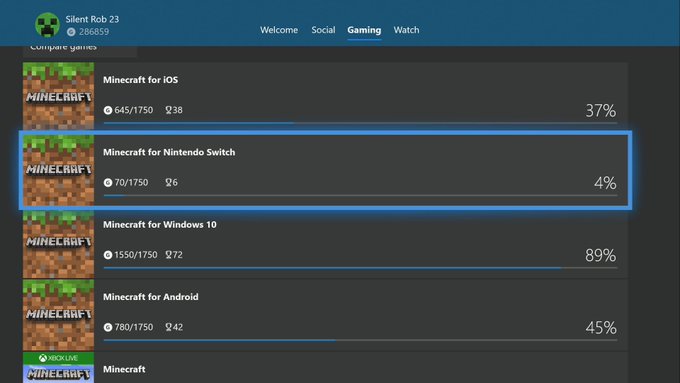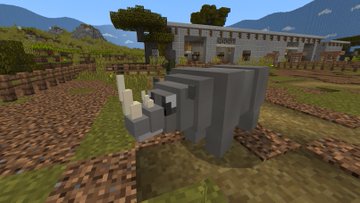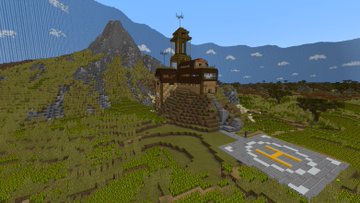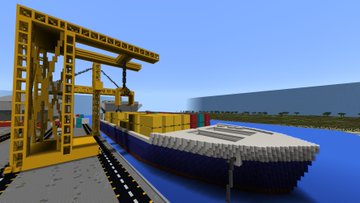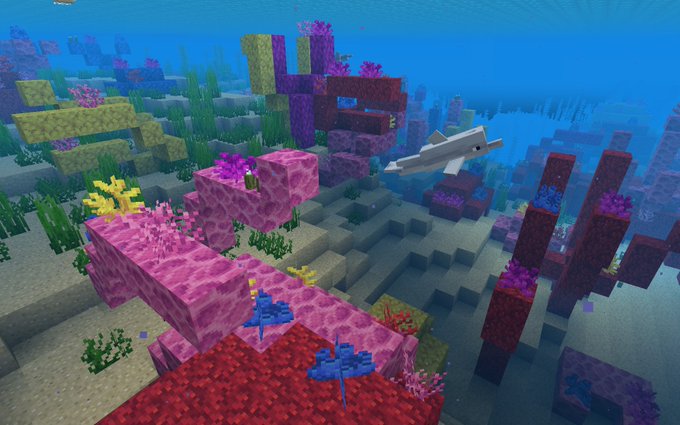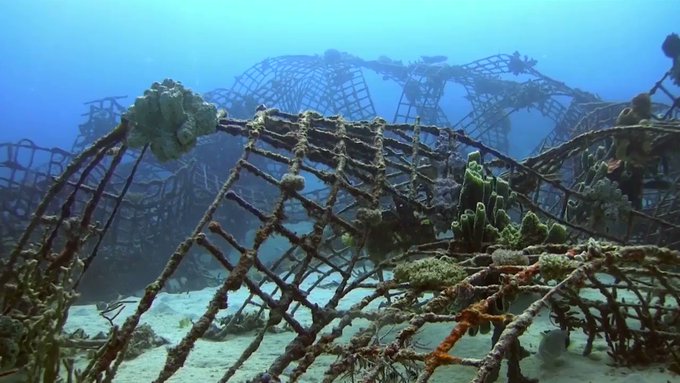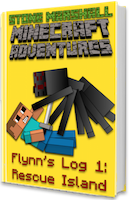The Minecraft Final Fantasy XV Skin Pack Turns the Beautiful Boys into Blocky Boys
For all of you who told Final Fantasy XV to ease off with the crazy property cross-overs around the time Valve dropped the Half-Life Gordon Freeman Noctis skin for the game, Final Fantasy XV has one message for you: “Can’t stop, won’t stop.” Final Fantasy XV has yet another franchise crossover up its sleeve, and it’s one I’m honestly surprised we didn’t see earlier: A crossover with Minecraft.
A brand-new skin pack for Minecraft lets you dress up the game’s blocky denizens as a host of Final Fantasy XV characters, from the obvious (Final Fantasy XV’s Four Beautiful Boy protagonists) to popular NPCs (Cid, Cindy), to some surprise appearances (Kenny Crow?).

Resetera member “AlexFlame116” posted screenshots of the PlayStation 4 iteration of the skin pack, which arrived with Minecraft’s 1.68 update. It’s is currently only available in select territories, including Australia’s PlayStation Store. Microsoft probably gave the pack to Australia first as a way saying “Sorry y’all have to live alongside taipan snakes.” That’s a nice gesture. Don’t worry: We probably won’t have to wait long before the pack comes to North America.
The Australian price for the Final Fantasy XV skin pack is listed as $4.85 AUD, which is roughly $3.99 USD. That’s a standard price for a Minecraft skin pack. If you ever aim to acquire a human skin pack, be prepared to pay a much higher price.
The Minecraft Final Fantasy XV Skin Pack Turns the Beautiful Boys into Blocky Boys
Minecraft gets another shot at Hall of Fame glory, and fans can help it this time
Among the nominees for the Strong National Museum of Play’s 2018 World Video Game Hall of Fame, one game stands out: All the other games are at least 15 years old–including Asteroids, Ms. Pac-Man, Half-Life, and King’s Quest–but Minecraft exited beta in 2011, making it the sole nominee born in this decade. The game has also earned a nod twice before–and it’s been snubbed twice before–in the Hall of Fame’s four-year history.
Arguably, the snubs happened for good reason. Past winners include classic games like Pac-Man, Super Mario Bros., Tetris, Space Invaders, and Donkey Kong, and some of the more modern winners—like Halo: Combat Evolved and World of Warcraft—have had their legacies tested for well over a decade. By contrast, Minecraft is still in active development by Microsoft, and while it’s prompted countless clones in the present day, we can still only guess at its long-term impact.
Then again, the Minecraft-loving masses could finally impose their will this year through a new Player’s Choice ballot. The top three winners will join 27 other ballots cast by industry experts, giving it a greater chance at earning an induction spot–whether it’s deserved or not.
That’s all well and good, as long as it doesn’t come at the expense of Ms. Pac-Man, which should have won a spot even before its male-centered counterpart did.
Minecraft gets another shot at Hall of Fame glory, and fans can help it this time
Microsoft has paid $7M to Minecraft content makers since June
One year ago, Microsoft announced plans to make a business out of Minecraft content, with a Marketplace program that lets creators sell their own maps, mini-games, and aesthetic tweaks. Now, the company tells me it’s paid $7 million to Minecraft creators since the program launched last June. That’s up from $1 million in payouts as of last September, and it’s enough for several creators to have quit their day jobs to make Minecraft content full-time.
The Marketplace isn’t yet a meaningful business for Microsoft, which paid $2.5 billion to acquire Minecraft developer Mojang in 2013, but the company hopes it eventually will be. To that end, Microsoft plans to ramp up its number of creators–only 45 have received invites so far–and give them better tools. In an interview, Minecraft head Helen Chiang said Microsoft is even looking into scripting APIs that would let developers sell the kinds of powerful mods that only exist on the game’s PC Java versions today.
Still, Microsoft will face some hurdles as Marketplace grows. The company must avoid alienating its existing partners and its already-vibrant community of hobbyist modders, while also making sure the store remains safe for children.
Read my deep dive into the business of Minecraft content creation for more on how Microsoft will take on those challenges–and perhaps turn the marketplace into as big of a phenomenon as Minecraft itself.
Microsoft has paid $7M to Minecraft content makers since June
Avengers: Infinity War review – colossal Marvel showdown revels in apocalyptic mayhem
Supersized set pieces, sharp one-liners and surprising deaths abound in the Russo brothers’ utterly confident comic-book movie mash-up
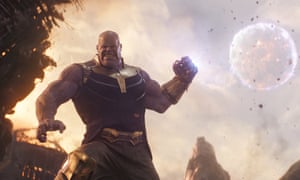
Not infinity perhaps, but a really, really big finity war. Colossal, cataclysmic, delirious, preposterous – and always surreally entertaining in the now well-established Marvel movie tradition. It’s a gigantic showdown between a force of cosmic wickedness and a chaotically assembled super-team of Marvel superheroes made more complicated by Doctor Strange’s tendency to multiclone himself in moments of battle stress.
There are some very unexpected family relationships that we had no idea about – potentially compromising unity in the face of encroaching evil. There are also some very surprising deaths – of which, of course, the less said the better. There are, moreover, some surprising omissions in the cast list. Or are there?
Avengers: Infinity War is a giant battle for which directors Anthony and Joe Russo have given us touches of JRR Tolkien’s Return of the King and JK Rowling’s Harry Potter and the Deathly Hallows. The film delivers the sugar-rush of spectacle and some very amusing one-liners.
Whatever else it does, this Marvel movie shows its brand identity in the adroit management of tone. One moment it’s tragic, the next, it’s cracking wise. It’s absurd and yet persuades you of its overwhelming seriousness. And there are some amazing Saturday-morning-kids-show moments when you feel like cheering.
Earth is being threatened by a massive malign hunk with a huge ridgey chin called Thanos, played by Josh Brolin. If he can gain ownership of all the talismanic infinity stones and place them in the holes in his custom-built gauntlet then he will have the ultimate power to destroy anything he wishes in the universe. And he has a chilling wish for mass slaughter of half the sentient beings in existence, ostensibly so that the other half will have enough food to eat – but really so they will bow down to him as the tyrant lord.
Ranged against him, of course, are the good guys who come together not in a single phalanx but a constellation of improvised groupings, in which the alpha males have a tendency to bicker. Tony Stark (Robert Downey Jr) is nettled by Doctor Strange (Benedict Cumberbatch) and his supercilious air of intellectual superiority – and vice versa. Spider-Man (Tom Holland) shows up and annoys the hell out of them both with his milliennial’s flair for pop culture references.
Thor (Chris Hemsworth) finds himself having to do a ride-along with the Guardians of the Galaxy and Peter Quill (Chris Pratt) is intimidated by Thor’s godlike machismo and finds himself trying to do the basso profundo voice.
Vision (Paul Bettany) and Wanda Maximoff (Elizabeth Olsen) are tormented by the glowing stone in Vision’s blue head, and they’re agonised by the thought that self-destruction is the only way to keep it out of Thanos’s huge mitts. Their own situation brings them into contact with Steve Rogers (Chris Evans) – who prefers his non-super name now, not Captain America, and also the always frowning Black Widow (Scarlett Johansson), together with the frankly traumatised Bruce Banner (Mark Ruffalo).
Scenes and situations whoosh by like a bizarre and bizarrely exciting dream. A sudden trip to Wakanda, with its secret world of remedial hi-tech surgery, seems entirely plausible. T’Challa, or Black Panther (Chadwick Boseman) greets the visitors with his habitual Shakespearean bearing and princely calm.
Inevitably, there is a little confusion. Groups of superheroes clash and each thinks the other is on Thanos’s side. “What master do you serve?” shouts one, awkwardly. “You mean – like Jesus?” comes the exasperated reply. No. Thor is the only god around here and even he isn’t guaranteed a result. It’s all in the cosmic balance.
In theory, all these superheroes crammed into one movie should trigger the law of diminishing returns and the Traveling Wilbury effect. And yet somehow in its pure uproariousness, it works. It’s just a supremely watchable film, utterly confident in its self-created malleable mythology. And confident also in the note of apocalyptic darkness.
I know it’s silly. And yet I can’t help looking forward to the next supersized episode of mayhem.
Avengers: Infinity War review – colossal Marvel showdown revels in apocalyptic mayhem
Avengers: Infinity War – the death, the destruction and Thanos – discuss with spoilers
It is tempting to wonder quite how the bigwigs at Disney must have reacted when the ending of Avengers: Infinity War was first revealed to them. “So let me get this straight,” they might have said, visions of billions of dollars in lost merchandise revenue whirling in front of their eyes. “You’re going to kill off half of all the superheroes in the Marvel Cinematic Universe, including the only guy – Doctor Strange – capable of bringing them back?”
In terms of far-out creative decisions, this one is right up there with Luke Skywalker’s declaration in Star Wars: The Last Jedi that he wanted nothing to do with laser sword-wielding space monks. Except that this time, we have to wait a whole year – until the sequel to Infinity War – to see if there’s any way of reversing it.
At least there were clues, hidden in the architecture of the Russo Brothers’ epic narrative, as to how we might get our MCU back. Here’s your chance to give a verdict on the movie’s key talking points, and perhaps offer up your own theories as to how Marvel are going to get out of this one.
The body count
Wow. Spider-Man gone, Star Lord gone, Black Panther gone. Doctor Strange, Nick Fury, Teenage Groot. The list goes on, and that’s just the superheroes who were destroyed with a click of Thanos’ fingers in that astonishing final scene on Wakanda as the mad Titan made good on his promise to destroy half of all life in the galaxy. We also lost Loki and Gamora earlier in the film.
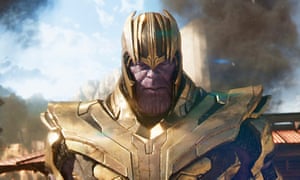
The competing superclans
Would you agree that the Russos did a decent job of uniting the MCU’s myriad tribes? There was something a little off about Chris Hemsworth’s Thor during those early scenes with the Guardians of the Galaxy, but generally the worlds knitted together well. The Wakanda scenes seemed to me to be the most tonally on point, perhaps because Ryan Coogler’s Black Panther had presented it as such a well-rounded vision earlier this year.
Old favourites such as Robert Downey Jr’s Iron Man and Mark Ruffalo’s Bruce Banner played their part in helping to iron out the kinks between competing super clans. Is Scarlett Johansson still getting $20m (£14.3m) to appear in these movies? If so, you might have thought Marvel would give the criminally underused Black Widow a few more lines.
Thanos
It was in those early scenes on board the ruined Asgardian ship that Gamora’s evil stepdad was established as a fully rounded CGI supervillain rather than the second-rate baddies we’ve seen so many times before in comic-book flicks. There in the shadows Josh Brolin’s intergalactic despot emerged for the first time as a living, breathing character capable of sharing the stage with high-calibre actors. It’s testament to Marvel’s work here that we already want to see more of him in part two.
Doctor Strange’s vision of the future
Surely herein lies our best hope of a reversal of those deaths. Strange reveals to Tony Stark at one point that he has travelled forward in time to scope out millions of possible futures, and that only one of these scenarios sees Thanos defeated. If the sorcerer supreme knows his mystic onions, we have to assume his decision to exchange the Time Stone for Iron Man’s life is based on his belief that Stark will play a vital part in ridding the galaxy of the oversized space meanie. But perhaps you have different theory?
A Strange death
The biggest issue here is that Benedict Cumberbatch’s reality-warping wizard is among those flicked into the void by Thanos. If we are to assume that the Time Stone is the only vehicle by which our favourite superheroes might be brought back from the dead, Strange would appear to be the most likely candidate to pull off the feat. We don’t yet know if Benedict Wong’s Wong made it, or whether he has the powers to wield the stone. Moreover, there’s the small matter of all six infinity stones remaining in Thanos’s possession.
In Infinity War’s only post-credit scene, moments before his death the former SHIELD supremo sends what appears to be a message to Brie Larson’s as-yet-unseen superhero. We know we’re going to meet Carol Danvers in next year’s Captain Marvel origins story. But where has she been, and why didn’t Fury call on her during the events of Age of Ultron?
Marvel Studios supremo Kevin Feige has said that Danvers may be the most powerful superhero yet seen in the MCU. Might she be capable of defeating Thanos and wielding the Time Stone to bring back all those lost heroes? This, of course, would have the effect of sending Captain Marvel back to wherever she came from, as Fury would never have sent that signal. Would we only get the superheroes back who died as Thanos clicked his fingers, or might Gamora and Loki also breathe again?
And that’s not the only mystery that will have to remain veiled in secrecy until part two rolls around. Can anyone out there explain what the Red Skull was doing on the planet of the Soul Stone?
Avengers: Infinity War – the death, the destruction and Thanos – discuss with spoilers
Inside Microsoft’s Quest To Turn Minecraft Content Into A Business
Stefan Panic and Joe Arsenault used to dream of building things in Minecraft for a living. But until recently, they couldn’t quite figure out how.
While Panic worked odd jobs and lived with his father, and Arsenault climbed the corporate ladder at Best Buy, they ran a 50-person volunteer collective called Noxcrew that built intricate environments and mini-games within Minecraft . To date, their work has been downloaded more than 1 million times. Yet all their attempts at making money–from Patreon donations to ad-supported download pages–have only been enough to cover their hosting costs.

In late 2016, Microsoft reached out with an offer that changed everything: The company wanted to discuss an official marketplace for Minecraft creations, which would allow groups like Noxcrew to sell their work directly to players. Like most of the other creators that Microsoft invited into the program, Panic and Arsenault trusted their guts and gave up their day jobs. Now, they make Minecraft content full-time, with help from 15 paid contractors.“We got the Marketplace opportunity, and it turned from a hobbyist community into an actual business,” Panic says.

Ten months after launching the Marketplace, Microsoft touts plenty of individual success stories like this. There’s the 16-year-old boy who’s paying for college with his Minecraftcreations, the Israeli startup that’s using Minecraft to make empowering content for young girls, and community mainstays like Arsenault and Panic who now have the means to increase their output. Microsoft tells Fast Company that it’s paid out more than $7 million to 49 Marketplace creators since last June–that’s after the company takes its 30% cut–and that people have downloaded Marketplace content more than 25 million times.“When I see the impact that it’s having—engagement with Marketplace content just continues to grow month-over-month—this is something we’re invested in for the long haul,” says Helen Chiang, Microsoft’s head of Minecraft. “And I’m just trying to figure out how we grow as fast as possible.”
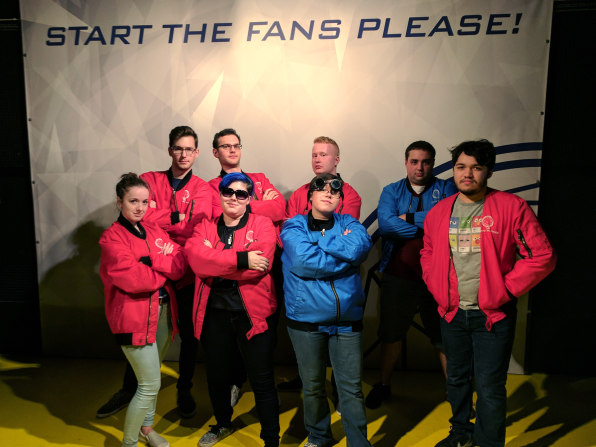
Now comes the hard part. While the Marketplace has already been life changing for a small number of creators, it’s yet to become a meaningful business to Microsoft, which spent $2.5 billion to acquire Minecraft developer Mojang in 2013. With roughly 74 million people actively playing Minecraft as of last December, and lots more creators clamoring to sell their work, the Marketplace could someday become as big a phenomenon as Minecraft itself. But along the way, Microsoft must ensure the safety of its predominantly young audience and avoid alienating its community members–many of whom have spent years building the Minecraft ecosystem for free. There aren’t many examples of companies that have successfully pulled this off.
TAMING THE WILDS
Microsoft isn’t alone in trying to profit off Minecraft‘s existing player base. Over the years, a booming business has emerged around Minecraftservers, which can host lots of online players, offer meticulously crafted environments, and provide items and abilities beyond what’s in the standard game. To support upkeep and development, many of the largest servers sell new items and upgrades for real money.
Until recently, Microsoft and Mojang had taken a hands-off approach to the third-party server business, mainly stepping in to outlaw pay-to-win schemes and brand-sponsored servers. Last summer, however, Microsoft started carving out a piece of the business for itself. Players can now access a few partner servers from a list that appears inside the game, and can use Microsoft’s Minecoins currency–purchased with real money–to buy items within those servers.
The Marketplace is Microsoft’s first step toward monetizing the rest of the Minecraft ecosystem, which involves modifications to the game that players download and install on their own. The Minecraft modding community is immense: CurseForge, a popular modding destination owned by Amazon subsidiary Twitch, hosts nearly 38,000 Minecraftmods, and the most popular ones have been downloaded millions of times. Curse even runs an ad revenue-sharing program that allows modders to earn money from their work.

Still, the vast majority of Minecraft mods only work with the Windows, Mac, and Linux versions of the game (collectively called the Java Edition, named after the programming language in which it was built). In recent years, the mobile and console version of Minecraft (now known as the Bedrock Edition) have become stronger sellers, and while they do support a limited form of user-made content, modding on the Java side is far more popular.Microsoft sensed an opportunity. With the Bedrock Edition, the company could turn modding into a business–both for itself and for creators–while giving parents a safe way to extend the game for their kids.
“We realized how much friction there was for players to find cool creator content in the Java edition,” says Todd Stevens, the director of Minecraft’s partner program. “A lot of times the websites you found it on had viruses and weren’t that safe. Parents were reluctant to give credit cards to some of these websites they didn’t know. We thought, when looking at this from a Bedrock perspective, if we created this safe marketplace . . . that we’d have a better environment for the player.”
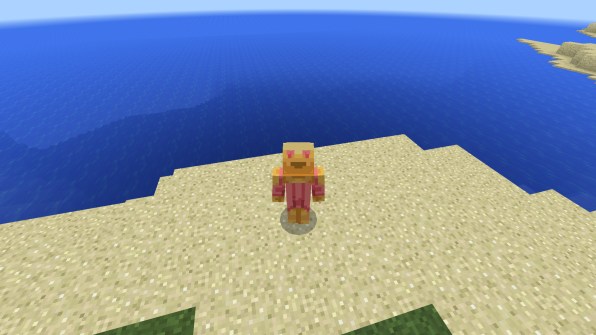
The Marketplace also presents a chance for creators like Jack “Visula” Steckler to make some serious money from their hobby. At age 13, Steckler started making “skin packs” that change how characters look in the game, and Microsoft invited him into the program last year based on the quality of his work. The company only discovered that he was 16 after asking him to sign a non-disclosure agreement.In an email, Steckler says he’s used his earnings to buy a laptop and “a few goodies” for himself and his family, but the vast majority of his profits have gone toward saving for college.
“Coming from a family that can’t afford to pay my college tuition, I knew it was important to use this opportunity to help continue my education and launch my career,” he says.
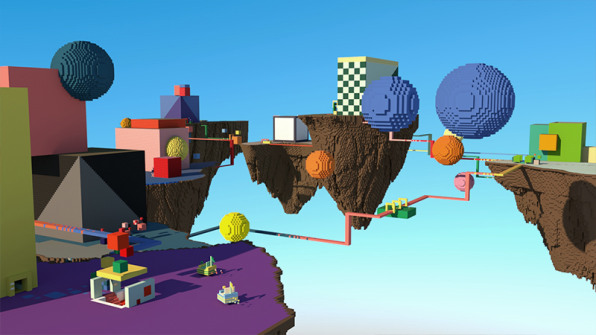
LEARNING FROM MISSTEPS
Trying to profit off a game’s modding scene can easily backfire. In 2015, about a year before Microsoft started planning the Marketplace, Valve announced a plan to offer paid mods—starting with ones for Bethesda’s The Elder Scrolls V: Skyrim—through its popular Steam PC game store. The announcement was a surprise, and the outcry was immediate, with complaints ranging from the meager revenue split (25% for modders, the rest for Valve and the game’s publisher) to the potential for content theft among creators. Valve rescinded its plans four days later. (The company does allow users to create and sell virtual items in a handful of games, and has paid out tens of millions of dollars to creators since 2011.)
To head off a similar backlash, Microsoft decided to give developers 70% of sales revenue before processing fees, which is in line with the revenue split on mobile app stores. Creators also get to retain ownership of their work, so they can theoretically reuse their assets and ideas outside of Minecraft.
“We were in a fortunate position where we could maybe learn from some of the things that had happened with other games,” Microsoft’s Helen Chiang says.
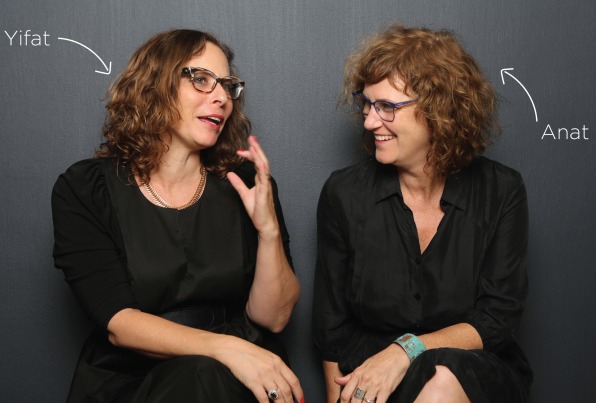
With its Marketplace creators, Microsoft has also tried to preserve the open communication that creators say was the norm with Mojang before the acquisition. Microsoft makes creators aware of its road map so they can plan for new features, and in some cases they can influence that road map themselves. Anat Shperling, the cofounder of an Israeli startup called Toya that makes empowering Minecraft adventures for girls, says some of her ideas have turned into future Marketplace features (though she declines to say exactly what those ideas are).“There is mutual exploration, because the Minecraft Marketplace team is exploring and developing the platform alongside the partners, so it feeds back on our own process, where we impact each other and discover the essence of this platform together,” she adds.
Regardless of how Microsoft approaches paid mods, some backlash would be inevitable—and Minecraft players, unlike Minecraft creators, are naturally wary of monetization schemes. When the company launched the Marketplace last June, complaints abound on forums like Reddit, accusing Microsoft of exploitation (for selling the kinds of content that had been available for free), alleging that the Java Edition might go away, and theorizing that Microsoft would actively remove popular mods from free download sites in order to charge for them.
Microsoft has tried to assure modders that it won’t curb their freedoms, and that the Java version isn’t in jeopardy.
“We’re not taking anything away with the Marketplace, and we encourage the community to continue making and sharing free content,” Chiang says. “Modders, both creators and players, on PC Java are an incredibly important part of the Minecraft ecosystem, and we encourage creativity within Minecraft in all forms and on all platforms.”
Still, there’s a kernel of truth to the criticism: Chiang says Microsoft is looking into a scripting API for Bedrock, which would allow creators to develop mods similar to those that exist on the Java version. As Microsoft opens up the Marketplace to more creators and gives them more sophisticated tools, the most talented creators could certainly decide to sell their work to players instead of giving it away.
The counterargument is that those creators deserve to be paid for their work, and that making a business of it would allow them to increase their output.
“We hope that as the Minecraft Marketplace grows, it will encourage even more players and content development teams alike to create their own work to submit to the Marketplace,” Chiang says.
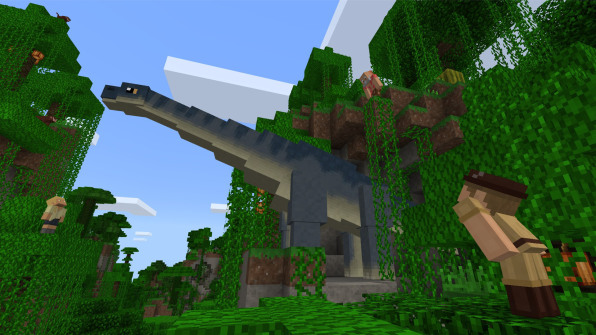
“THOUGHTFUL GROWTH”
When Microsoft announced the Marketplace a year ago, “hundreds and hundreds” of people applied to be part of it, Todd Stevens says. But since then, Microsoft has moved slowly, only letting in nine partners at launch before expanding to the current 49. The challenge now is figuring out how to let in more creators without compromising the Marketplace’s quality or harming creators’ ability to make money.
“We talk about that all the time,” Stevens says. “I use the term around here called ‘thoughtful growth.’ . . . I could have quickly signed up 200 partners, but to be honest, our Marketplace wasn’t ready for that much content and that many partners.”
Initially, for instance, the Marketplace didn’t have a search function or a way to filter results. Microsoft also had to set up an editorial team to play all incoming content, provide feedback to creators, and decide which creations are worth selling and promoting in the store.
Now, Microsoft simply has to hire more people. The company insists on screening all incoming content through human moderators, and Helen Chiang says that’s not going to change anytime soon. She’s aware of how filtering algorithms can fail on sites like YouTube, and isn’t willing to take the same risks with Minecraft, a game with a vast following among kids.
“I would rather spend the extra time making sure the content is safe before it goes up than having to put really strong procedures on how we take down content,” Chiang says. “When I think about the demographics of our user—and we have some that are quite young—I don’t want to be exposing them to content that isn’t safe.”
Staffing up with moderators can easily become an expensive endeavor. One of Minecraft‘s primary competitors is Roblox, a platform that lets players make and share games using Lego-like virtual blocks. Like Minecraft, Roblox caters to a predominantly young audience, and while the company uses automation to detect abuse in multiplayer games, it still subjects every new game submission to human review. To that end, Roblox employs hundreds of people, who accepted 11 million submissions for user-made content last year.
“We have more moderators on our staff than other employees,” says Craig Donato, Roblox’s chief operating officer.
Despite the potential for problems, Chiang acknowledges that scaling up the Marketplace team is one of Microsoft’s top priorities for Minecraft .
“Really this is just based on the capacity of our team and what we’re able to take on, but we’re growing the team and increasing the pipeline of partners that we’re able to bring onto the Marketplace,” she says.
As Microsoft lets new creators into the Marketplace, it must also devise new ways to promote their work. Currently, the company dedicates some store space to items chosen by its editorial team, and will soon sell a “Creators Pack” that bundles the base game with content from Marketplace partners. But Roblox goes a step further, letting creators pay to promote their work in its marketplace. Because these paid promotions rely on the same Robux that players can earn by selling their works, popular developers are able to plow some of their earnings back into advertising for new creators.
“Roblox is not only a platform, but it’s also an economy,” Donato says.
It’s unclear if Microsoft would do something similar, but Stevens floats the idea of a different approach: Instead of lumping everything into one marketplace, Microsoft could open a separate storefront with a more freewheeling approach toward user submissions. Still, even he seems uncertain about whether Microsoft would go down that path.
“You have to be careful with those. We see a lot of those types of digital marketplaces in other games, and you can kind of get lost as a player,” he says. “You’re not quite sure what to spend on, there tends to be a lot of competition on price, so prices race to the bottom, and players don’t reinvest in making more content.”
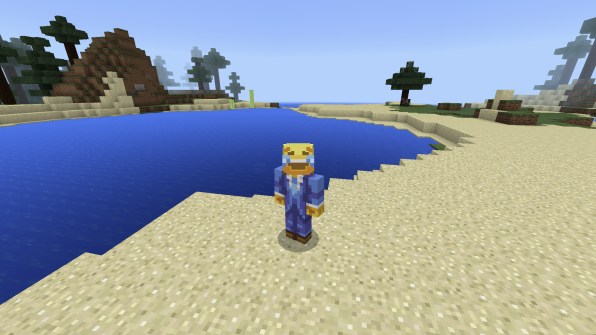
PAYING IT FORWARD
While the Minecraft Marketplace has plenty of challenges ahead, if successful, it could also become a blueprint for the rest of Microsoft to follow.
Minecraft is already showing Microsoft how to handle cross-platform gaming, which the company is now pursuing though its new cloud gaming division. The Marketplace, Chiang says, could also be an example of how other Microsoft games could launch their own stores for user-made content.
“I hope that we are the tip of the spear, especially in thinking about content moving with players across platforms and devices,” Chiang says. “I think that’s something we should celebrate as important to our players. Minecraft is a game that you should be able to play anywhere, and when they purchase something, we hope that they can enjoy that experience on any devices that they have.”
That said, it’s still early days for the Marketplace, and Microsoft won’t say whether it’s considering a similar model for other games. For now, Chiang is just happy to see Minecraft creators turning their hobbies into full-time work–though she’s not surprised it’s working out that way.
“We know that we’ve had a ton of people making content in their spare time,” she says, “and I think it absolutely was part of how we thought about the future for them.”
Inside Microsoft’s Quest To Turn Minecraft Content Into A Business
Minecraft for Nintendo Switch getting Xbox achievements
Nintendo Switch doesn’t have a built-in achievements system, a la Xbox Achievements or PlayStation Trophies, but the Switch version of Minecraft will soon bring Microsoft’s brand of achievements to the platform.
A set of Xbox Live achievements for Minecraft for Nintendo Switch was recently spotted by content creator Patrick Maka, who posted about the finding on Twitter, and by achievement tracking website True Achievements. The achievement list appears similar to the Xbox versions of the game as well as those on non-Microsoft platforms, like Android and iOS. (PlayStation versions of the game do not tie into Xbox Live Achievements.)
A representative for Minecraft confirmed to Polygon that the game’s Switch version will indeed track Xbox Live Achievements later this year.
“We can confirm that Minecraft players on Nintendo Switch will soon be able to earn achievements tied to Xbox Live once the Bedrock update is released,” a Minecraft spokesperson said in an email.
Minecraft: Nintendo Switch Edition was released in 2017. The game’s Bedrock update started rolling out in September 2017 and allowed players on Xbox, mobile, VR and PC to play across those various platforms.
Earth Day Special Events Abound with Minecraft, Pokemon Go, and More
Earth Day gives us the chance to look back at our home and reflect on how we have treated dear Mother Earth over the year. It also means we get a bunch of really cool special events to tide us over!
For starters, Minecraft has partnered with United for Life to create the We Are The Rangers special lessons for MinecraftEducation–a special edition devoted to bringing Minecraft to the classroom and promoting education. The new partnership will create a world that takes place in a ranger station, a shipping port, and a DNA lab to teach students about the science of animal conservation.
We also have a special live event from Pokemon Go promoting players to pick up trash in partnership with Playmob and local NGOs. Hopefully, this live event will go over better than previous ones.
Players will receive rewards for working with the local non-profit in cleanup events around their neighborhoods and the joy of a job well done. You can check out what events are near you by checking out the website here.
Rewards include:
- 1,500 players cleaning up trash:
- Unlock 2x Stardust when catching Ground-, Water-, and Grass-type Pokémon
- 3,000 players cleaning up trash:
- Unlock 3x Stardust when catching Ground-, Water-, and Grass-type Pokémon
Finally rounding up our group of Earth Day events comes from puzzle-RPG mobile game Legendary Game of Heroes, which launched a Slayer event in which proceeds will be donated to Rainforest Trust. The event is wrapping up today and has succeeded in raising its $75,000 donation goal, but there’s still time to log on and obtain event exclusive rewards, catalysts and heroes.
That’s about it for this roundup of notable recent Earth-y events. There are plenty other games doling out some Earth Day rewards in addition to these, so be sure to check out your favorite games for any special events and rewards!
Earth Day Special Events Abound with Minecraft, Pokemon Go, and More
Minecraft aiming to use ocean update to restore real coral reefs
(RNN) – Minecraft, an immersive computer game in which players use blocks to build the world they inhabit, is now trying to build something in the real world.
The makers of the game are using a new ocean update – which will be the first to give players a chance to focus on building underwater worlds – to promote rebuilding actual corals.
The game’s website announced the initiative, the Coral Crafters regrowth project, on Tuesday.
Developers are planning six Biorock installations, fixtures placed in ocean waters around which new reefs can grow. They are said to facilitate far quicker growth than natural reef processes.
They intend to put them off the coast of Cozumel, Mexico.
Biorock structures can be arranged in elaborate designs, and Minecraft’s site said three of its fixtures will be fashioned to look like two of its iconic block characters, Alex and Steve, as well as a sea turtle.
The other three will be designed by popular YouTubers who play the game.
One, Rabahrex, will work with schoolchildren in his native Mexico on a design. Another, Logdotzip, is allowing fans to vote from three designs for the final one he will submit.
Reefs are collections of small marine animals called polyps, which come to host the algae that gives them their fantastic colors in a symbiotic relationship.
According to a recently-updated post on the website for Columbia University’s Earth Institute, 75 percent of the world’s coral reefs face environmental risk and a quarter are already permanently damaged.
Citing a report by the World Resources Institute, 90 percent of coral reefs could be in danger by 2030, and possibly all of them by mid-century.
Reefs are one of the most important habitats for marine species. Fishing and pollution have long threatened them, and now warming waters are frequently resulting in what’s called coral bleaching. That process robs them of their rich colors, and more seriously can lead to disease, reproductive issues and death.
A report published in the journal Nature this week notes that Australia’s Great Barrier Reef, the world’s largest and most famous reef, lost a third of its corals in a bleaching event in 2016. The lead author of the report, Terry Hughes, told The Atlantic that initial research indicates a heat wave last year triggered another bleaching, and the reef has now lost half its corals since 2015.
“We can do something about this – with YOUR help!” the Minecraft post says.
Minecraft aiming to use ocean update to restore real coral reefs
How to avoid Minecraft Virus
An Avast report claims that almost 50,000 computers have been infected by malware in the past 30 days via infected Minecraft skins. The malware is said to package itself as an unsuspecting PNG file, ready for fans of the game to download from the official Minecraft domain. It’s not to be trifled with either, as the malware can cause serious damage to your PC, wiping your hard drive and destroying backups.
Don’t panic, though; here, we explain what the Minecraft malware is, how to avoid it and what to do if you’ve got the Minecraft virus.
What is the Minecraft Virus?
According to Avast data from the past 30 days, there have been nearly 50,000 Minecraft accounts infected with malware that could potentially reformat hard-drives and delete both backup data and system programs.
The Powershell script identified by Avast experts is apparently smuggled onto unsuspecting gamers’ computers via Minecraft skins. The script is created in the same PNG file format used for Minecraft skins, making it hard to identify potentially malicious Minecraft skins on the surface.
Avast has admitted that the malicious code is largely unimpressive, and can be found on sites that provide instructions on creating viruses with Windows Notepad. The simplicity suggests that it’s not backed by professional cybercriminals, though the skins are hosted on the official Minecraft domain.
A Microsoft spokesperson has since said that the company “has addressed this issue and put additional measures in place to protect our community” and that players should “report any suspicious activity to feedback.minecraft.net.”
How can I avoid the Minecraft Virus?
The key thing right now is avoiding the HDD-reformatting malware – the good news is that it shouldn’t be too hard to steer clear. The easiest way to avoid the malware is to simply not download any skins from the official Minecraft domain while Mojang fixes the issue and removes any infected files.
If you simply can’t wait, you could try and avoid any of the skins that Avast claim feature malware. A screenshot of the skins is provided below – just avoid those skins, and any that look like them for now.
If you don’t want to risk it, then why not try one of our favourite Minecraft alternatives?
What should I do if I’ve downloaded malware from Minecraft?
If you’ve found unusual messages in your Minecraft inbox along the lines of “You have maxed your internet usage for a lifetime”, are experiencing performance issues or receiving error messages related to disk formatting, chances are you’ve downloaded a malicious Minecraft skin.
Don’t panic; Avast recommends scanning your machine with free (or paid) antivirus softwarelike Bitdefender Total Security or Avast Free Antivirus. The company claims that most should be able to identify the malicious file and remove it for you, although some users may need to go through a few extra steps. Some users claim that the malware ‘breaks’ Minecraft for them; if this is the case for you, you need only reinstall the game from the Microsoft Store.
Now, if your computer has become completely infected and system files have already been deleted, you may need to completely reset your PC.
‘Minecraft’ Developer Issues Fix for Skins Virus
“Minecraft” players who like to download customized skins for their character avatars don’t need to worry about malware anymore, developer Mojang said Wednesday. The company said it resolved the issue by releasing a patch that removes all of the information from skin files except the actual image data itself.
The studio’s assurances came one day after cybersecurity company Avast claimed hackers were distributing malicious software via skins created in the PNG file format and uploaded to “Minecraft’s” official website. The virus could potentially reformat a person’s hard drive or destroy their backup data. It estimated nearly 50,000 “Minecraft” accounts were infected. That is a pretty low number, though, when compared to the game’s 74 million active players worldwide.
“The malicious code is largely unimpressive and can be found on sites that provide step-by-step instructions on how to create viruses with Notepad,” Avast said. “While it is fair to assume that those responsible are not professional cybercriminals, the bigger concern is why the infected skins could be legitimately uploaded to the ‘Minecraft’ website. With the malware hosted on the official ‘Minecraft’ domain, any detection triggered could be misinterpreted by users as a false positive.”
While people who upload skins could potentially slip extra code into the PNG files, Mojang points out that code can’t be run or read by the game itself. “Additionally, even if you found the code within the file and chose to run it, your antivirus software should detect and block the attempt,” it added.
“Minecraft” is one of the biggest games in the world, having sold more than 144 million copies since its launch in 2009. Microsoft bought both it and Mojang for an estimated $2.5 billion in 2014. Its next big update will add a variety of ocean-themed creatures, blocks, and items. It comes out later this year.
REVIEW: PACIFIC RIM UPRISING
Once the Honeymoon effect finally wore off for the new Pacific Rim Movie, and I gradually put together in my head what the sequel’s story was, one important question rang in my head: have we run out of original plot lines? I don’t have anything against Pacific Rim Uprising, as it’s not a movie that anyone (or that I would recommend anyone) goes to watch for its gripping story; there’s about 50 years of giant robot fighting movies with original stories from Japan. However, it is something I do want to address simply because it’s growing increasingly hard for me to work out what audience Pacific Rim is beginning to cater for. The level of nods and winks towards the series’ spiritual past in anime would lead anyone to believe that it’s a nostalgia piece, designed to either bring in current fans of the mecha genre, or even to draw in new fans.

But at the same time, this movie isn’t anything like its acclaimed ‘origins’. If anyone was to watch the likes of Evangelion, the Gundam Series, or even the more recent Aldnoah Zero,based on what theysaw from Pacific Rim Uprising (despite all the emphasis put on reminding us that its roots are inherently Japanese), they’d see a huge difference. I noticed the same disparity watching it; the plot was more hastily put together, and less character development was shown – instead opting for oddly placed monologues.
The surviving characters from the previous movie weren’t developed, but left as stagnant background characters, and the plot wasn’t as much an engaging and cohesive story, but seemed more of a vessel to carry characters to the next giant robot fight. I couldn’t quite put my finger on what I could best relate this series to in relation to the background material it was supposedly derived from – until I was reminded of another robot fighting movie that has its origins in cult animated shows. I’m sure a lot of fans of Pacific Rim are going to get very, very mad at me for making this assumption, but Pacific Rim feels like the Transformers of Evangelion. I’m not saying this is a bad thing: the live action Transformers movies have their place (or at least we infer they have their place based on the profit Michael Bay makes from them), and this ‘place’ is probably not too far from the place the Pacific Rim series currently resides, but the relationship is irrefutable now I’ve seen it.
The previous movie, despite it being ‘A big dumb robot fighting movie’, was an interesting spin on the ‘monster vs robot’ fighting genre. I would have found it hard to hate Pacific Rim no matter what state it came out in simply because one of my favourite directors of all time, Guillermo Del Toro, directed it. He did a decent job with setting up the world, the characters, and the story-line in an engaging perspective of a well-known trope of international cinema, brought to a western audience. This interesting and diverse world also passes over into Pacific Rim Uprising, set several years following the events of the first film, in a world that is slowly recovering and developing from the previous ‘Kaiju’ invasion. As far as excuses to have giant mecha suits fight each other, this is probably the most engaging, if not believable, set-up. The special effects, just like the first movie, are top-notch, and equally the designs of the monsters and the Jaegers deserve commendation. The Jaegers especially seem decidedly… Japanese, while also in-keeping with their own designs and clear influences from other cultures.

John Boyega’s performance was decent, if not a bit cliched. It is refreshing for a movie to avoid ‘Americanising’ its British actors by forcing them to put on contrived American accents; a trait unfortunately found in other blockbusters (I’m looking at you, Star Wars). His supporting actress, Cailee Spaeny also performed admirably in a rather illustrious debut role in cinema. Burn Gorman and Charlie Day, like in the 2013 Original Pacific Rim, once again presented perhaps the highlights of the movie for me in their performance, even if Charlie Day’s performance is essentially Charlie Kelly from It’s Always Sunny in Philadelphia with a PhD in Molecular Biology. The new additions to the cast (the sci-fi high school starter pack straight out of Ender’s Game) aren’t as well written. To the credit of their actors, they perform the roles believably, but they feel like a generic excuse to have a mentor-student relationship between Boyega and Spaeny’s characters, because that’s still ‘in fashion’ right now. I think the lack of emphasis on their character development is best conveyed when one of them dies in battle, and… that’s it. One other character slaps the floor, and the rest of the cast makes an awkward shuffle, but nothing else. Their death isn’t even mentioned again in the entire movie, so I guess I’ll take that as free rein not to even count it as a spoiler. It must leave a bad taste in your mouth when even the movie you’re acting in forgets you before the end credits have started to roll. Let’s hope the pay check wasn’t forgotten.
The fight scenes are good, and the CGI is top-notch, but let’s be honest, the story isn’t really what everyone goes to watch it for these days, is it? Kind of like Transformers, but with a better plot and more Japan. It is an action movie with explosions, guns and giant aliens that fight each other and somewhere down the line, the earth is in danger for some reason. Sit back, enjoy this very entertaining movie, and bathe in the pyrotechnics, just don’t stare too closely at the bits in-between.
Inaugural HB show fits well with Lego fans
With a laugh Hastings Lego enthusiast and builder Tim Stevens said the most challenging part of working with his two remarkable 1.8m long castle and battle-themed creations was not so much the construction.
“It’s getting them there in one piece,” he said.
/arc-anglerfish-syd-prod-nzme.s3.amazonaws.com/public/T7P2IPNKKND5DESUIEVMJBTZYU.jpg)
“There” is the Taradale High School venue for the inaugural Hawke’s Bay Brick Show 2017 – a Lego exhibition for all ages sponsored by Napier Toyworld which will feature about 30 remarkable and imaginative creations from local Lego aficionados as well as top builders from throughout the country.
“It is the first one to be staged here and it is going to something pretty special,” Mr Stevens said.
/arc-anglerfish-syd-prod-nzme.s3.amazonaws.com/public/EXSWSAKF7BEMNGTDWFOQY2L5UY.jpg)
The show has been organised by about 30 members of the Hawke’s Bay branch of Well-LUG (Wellington Lego User Group) which has branches in the greater Wellington region, Palmerston North, Wairarapa and now the Bay.
“We started the branch here about a year ago,” Mr Stevens said, adding that now being able to stage a national-scale show of the world’s most popular building brick would cement it in place – and likely attract more members.
Like most, he got the Lego bug when he was only 3 or 4 and like the creations he began to build, it grew from there.
“I remember standing in a store staring at all the sets on the wall and wishing I could have everything.”
He couldn’t, but has ended up with about “a thousand men and a couple of hundred horses” – he has always been drawn toward the battle themes and “castle stuff” with figures and horses.
“I’m not the best builder. Some of what people will see at the show is quite incredible.”
There will be everything from a giant train set, Minecraft and Lord of the Rings settings as well as what the club terms ‘MoC’s – my own creation.
“There is no limit to what can be built and there are going to be a lot of different things to see.”
As well as the displays the show will feature a Lego play area for kids to get creative in.
Lego, Mr Stevens said, was a good “hands-on” physical way for youngsters to get creative and learn design and build general motor skills in understanding art, shapes and construction.
And as he explained, it didn’t take a lot of four-by-two blocks (two attachment studs on one side and four on the other) to make something different.
As the Lego sites illustrate, if you have just two of them they can be arranged in 24 different ways.
But if you have six blocks you can arrange them 915 million different ways – yep, 915 million.
“No I haven’t worked that out myself,” Mr Stevens said with a laugh.
“I think they used a computer to come up with that.”
The Hawke’s Bay Brick Show 2017 will be open on Saturday and Sunday at Taradale High School between 9am and 5pm with a $2 admission, and kids under 3 free.
Minecraft and Lego help students prepare for emergencies
Students at Maraekakaho School have been using two popular children’s pastimes to help their community become more prepared for an emergency.
The students have been using online video game Minecraft and Lego building blocks to map their community; locating its hazards, vulnerabilities and resources that could be useful in an emergency.
This is part of a research project to trial the use of these two popular pastimes for disaster risk reduction and explore if these are effective tools for children to use.
Researchers from the University of Auckland, Auckland University of Technology (AUT) and East Coast LAB (Life at the Boundary) developed a series of lessons and activities for the students to learn more about natural hazards, vulnerabilities and resources.
Year 6 student Raiha said they had started off in the classroom “mapping our hazards and resources on really big maps using lots of stickers, pins, and string”.
The students were then divided into groups to build their maps using Minecraft and more than 10,000 Lego blocks.
“I really enjoyed playing on Minecraft to build the map of our school and learning about the hazards that have affected us in the past,” Year 5 student Jodi said.
A group of 12 students have been documenting the process on video. It will be released online once the project has been completed.
Researchers are also working with other members of the community to help develop a Community Resilience Plan with the Hawke’s Bay Civil Defence emergency management group.
This is part of a two-year research project funded by the Resilience to Nature’s Challenge strand of the National Science Challenge.
For more information visit: www.eastcoastlab.org.nz/our-science/our-projects/participatory-technology/
Real-world Minecraft mod: How the popular video game is transforming parks and other public spaces
Where there was once a derelict market in the Sunny Hill neighborhood of Pristina, Kosovo’s capital, now sits a skate park. Rollerblades, skateboards, and BMX bikes make a constant clatter as kids and teens roll up and down the half-pipes, quarter-pipes, and ramps. The popular public space is very much a brick-and-mortar endeavor, but it owes its existence to Minecraft, whose parent company was bought by Microsoft in 2014. In the process, the Redmond, Wash., company absorbed an innovative social project involving the United Nations.
The $2.5-billion acquisition made waves in the video game industry as Microsoft moved in to scoop up the immensely popular world-building platform from Swedish company Mojang. Despite initial fears in the rabid Minecraft community, the game continued to grow in popularity and spun off a deeply discounted education version for schools.
The pedagogical potential is precisely what captured the attention of Deirdre Quarnstrom, who was intimately involved with the acquisition as chief of staff to Phil Spencer, the head of Microsoft Xbox. She is now the general manager of Minecraft Education, and an early booster of one of Mojang’s Minecraft side projects: Block by Block.

The $2.5-billion acquisition made waves in the video game industry as Microsoft moved in to scoop up the immensely popular world-building platform from Swedish company Mojang. Despite initial fearsin the rabid Minecraft community, the game continued to grow in popularity and spun off a deeply discounted education versionfor schools.
“It’s somewhat unique in the gaming industry to have a very popular videogame reaching outside the entertainment space and being involved in things like urban planning,” she told GeekWire.
In 2012, before the acquisition, a Swedish architect and the parent of a Minecraft devotee came to Mojang with an idea. What if Minecraft, with its digital Lego-like tools making for easy mock ups of buildings, were used in an urban design workshop with everyday people? Architect software like Google Sketchup or AutoCAD is far too sophisticated for laypeople, but they are the ones whose input urban planners are always seeking when it comes to new designs for infrastructure, whether a new mass transit station or a proposed public park.
Minecraft-as-civic-participation went so well in Sweden that the architect brokered an introduction between Mojang and UN-Habitat, the United Nations lead agency for cities. The result was a memorandum of understanding whereby Mojang would help UN-Habitat deploy Minecraft in cities where the agency was coordinating the renovation or creation of public spaces. They called it Block by Block.
“We were amazed that people were interested in using a video game for something that felt so serious,” Mojang COO Vu Bui told GeekWire.
Since then, UN-Habitat has used the platform for 40 projects in 35 cities in 25 countries, like the market-turned-skate park in Pristina. The software has traveled far and wide to help redesign fishing docks in Haiti, a park for immigrant children in Anaheim, and a Mumbai slum.

“In project after project I am amazed how quickly people can learn the tool and start expressing themselves,” UN-Habitat’s Pontus Westerberg told GeekWire. “Even people with no previous computer experience can pick it up in half a day or less. We’ve worked with people from slums all over the world. It’s a great empowering experience for them.”
While anyone can learn Minecraft — the team was impressed that older Haitian men redesigned their fishing docks with no prior computer experience — tech-savvy youth have a natural advantage. That gives them a more powerful voice compared to traditional public input processes. “If we have a couple of teens paired with adults in their 30s or 40s, usually the one sitting at the keyboard holding the mouse is one of the young ones,” Bui explained.
He recalled one of the Haiti projects as particularly empowering for young women, where teenage girls stood up at the public meeting to defend their proposal. “We push that their must be youth and equal gender representation,” Bui said. “We don’t want our workshops to be middle-aged men.”
Once Microsoft took over, the tech giant shepherded the ad-hoc arrangement between Mojang and UN-Habitat into a formally incorporated 501(c)3 non-profit, the Block by Block Foundation. Both Quarnstrom and Bui sit on the board of the foundation, which now operates with a roughly $2 million annual budget funded by royalties from Minecraft merchandise sales, settlements from Minecraft licensing disputes, and individual donations — Microsoft employees chief among them.
Quarnstrom is a hands-on board member, visiting sites around the world, including the Pristina skatepark, to personally vet projects before signing off on the roughly $100,000 that Block by Block contributes in licenses and funds for consultants to run the public meetings.
In Anaheim, she watched the children of immigrant workers build a vision for a neighborhood park in two hours. In Hanoi, she listened to teenage girls articulate a vision for better lighting on their route to school.
“It’s pretty eye-opening to the architects, landscape architects, and city planners to see how valuable and enthusiastic the input is from the community,” she said. “Even in the developed world when running a public input process, it’s hard to make the connection with blueprints, but when you provide them with a 3D virtual model of the space [the audience] becomes much more engaged.”
The journey from the virtual world to the real world sometimes leaves Quarnstrom bewildered at Minecraft’s versatility. “Sometimes it feels a little surreal to me when I’m on the phone with three or four city planners as the representative of a video game,” she said. “But it’s because the game does have an impact.”
Real-world Minecraft mod: How the popular video game is transforming parks and other public spaces
Free beginner Minecraft camp held at MSU
Kids who have never experienced the online gaming platform Minecraft can apply for a free summer camp called Minecraft 101. The camp, which will be held at Montana State University, is for youth who will enter grades 4 through 7 this fall.
Minecraft is known as a fun and interactive platform that increases creativity, critical thinking and problem-solving skills. Students will be led through hands-on design challenges that allow them to practice spatial skills while they craft their own online worlds and explore science, technology, engineering and math.
Minecraft 101 is free for accepted applicants. However, no travel funds or overnight lodging is provided. The camp lasts from 9 a.m. to 4 p.m. on two consecutive days.
Two identical sessions will be offered on Aug. 14-15 and Aug. 16-17. Students can indicate which session is better, but instructors cannot guarantee placement in a specific session.
The camp is hosted by the MSU departments of education, electrical and computer engineering, and physics; and the Montana Engineering Education Research Center (MEERC), with funding from the National Science Foundation. To download an application, visit MSU Academic Technology and Outreach at ato.montana.edu/minecraft. The deadline to apply is Friday, May 11.
For more information, contact Nicole Soll with MSU Continuing, Professional and Lifelong Learning at Nicole.soll1@montana.edu or 406-994-6550.
Minecraft console commands and cheats every player should know
Whether it’s to copy an existing build, change the gamemode, or flat out cheat your way to glory, Minecraft console commands are an important part of playing the game day-to-day. While there are a lot of different commands out there, all varying in complexity, we’ve got a run down of the ones you need to know, and, of course, the ones you can use to troll your friends. Because what’s Minecraft without a bit of friendly griefing?
If you’re wondering how to enter the Minecraft console commands listed below, all you need to do is hit the forward-slash key (/) and that’ll bring up a small window. Input the code and hit enter and your command will activate.
Shorthand Codes
Below are the shorthand codes to save you from typing in different player names. These are worth memorising so you don’t have to type in names like “Sniper_Kitty_Bruv_91” every time some jobber joins your game.
The clone command
/clone <x1> <y1> <z1> <x2> <y2> <z2> <x> <y> <z>
Clones a selection of blocks to another location. Very helpful if you’re building a city space and want to duplicate multiple buildings to different areas. “<x1> <y1> <z1>” is your start point. “<x2> <y2> <z2>” is the end point. And “<x> <y> <z>” is where you want the cloned blocks to spawn.
Example: /clone 100 234 -10 200 100 0 300 200 100
How to change the difficulty
/difficulty <difficulty>
Changes the in-game difficulty. Replace the latter section of the code with one of the following:
Example: /difficulty peaceful
Add an effect to yourself or someone else
/effect <player> <effect> [seconds] [amplifier] [hideParticles]
Adds a status effect to the targeted player. “[seconds]”, “[amplifier]”, and “[hideParticles]” are all optional conditions, so feel free to ignore them unless you want to change the length, how strong the effect is, or whether the effect shows as particles or not. If you want to remove an effect from a player, type “/effect <player> clear”.
Example: /effect PCGamer water_breathing 30
Enchant an item
/enchant <player> <enchantment ID> [level]
Adds an enchantment to the item the player is holding. So that’s smite, bane of the arthropods, sharpness—any enchantment you’d pull from a book or enchant table. Here’s a list of Enchantment IDs.
Example: /enchant PCGamer minecraft:smite 1
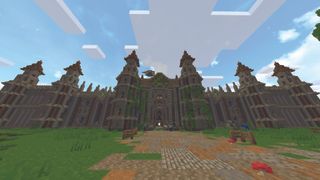
Exp modifier
/xp <amount> [player]
Gives the targeted player an amount of experience points. If you just want to add levels instead, which is easier for enchanting, try “/xp <amount>L [player]”.
Example: /xp 100L PCGamer
Change the gamemode
/gamemode <mode>
Changes the gamemode for everyone in the session. Add a player’s name to the end of the code to alter the mode for different players. Replace “<mode>” with one of the following options:
Example: /gamemode Survival
Give an item or items
/give <player> <item> [amount]
Drops an item into the player’s inventory. Perfect for if you want to start a run with a full set of diamond gear. Just keep in mind the amount section only works for stackable items. You can’t give yourself 100 diamond swords in one go, as cool as that’d be. For a full list of item IDs, head here.
Example: /give PCGamer diamond_sword 1
Help if a command isn’t working
/help [command name]
Offers additional information about any console command. If you’re trying a command and it isn’t working as it should, type the above command before the name of the command that isn’t working and you’ll be treated to more details about how it works.
Example: /help kill
Turn keep inventory on
/gamerule keepInventory true
Changes the game rules so should you die, you keep all the items in your inventory. Replace “true” with “false” to turn it off again.
Kill everyone or everything
/kill
Kills everything, including the player. But should you want to kill another player, use “/kill <player>”. And to kill a certain type of mob, “/kill @e[type=mobType]”.
The play sound command
/playsound <sound> <player>
Plays a specific sound file. Great for if you want to use a command block to play a sound when someone opens a door. Who doesn’t love a good doorbell? Take a look at all the sound file names here.
Example: /playsound minecraft:entity.elder_guardian.ambient voice @a
How to check the world seed
/Seed
Displays the seed for their current world should you wish to replay the seed again from scratch or pass it along to a mate.
Set the world spawn
/setworldspawn
Changes the world spawn to wherever the player is standing. If you don’t want to do that, you can also set it to a predetermined location with “/setworldspawn <x> <y> <z>”
Example: /setworldspawn 100 80 0
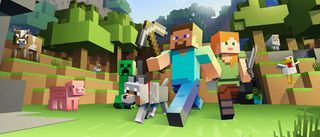
Stop time from changing
/gamerule doDaylightCycle false
This completely turns the daylight cycle off so it’ll always be the current time of day. To reenable the cycle, replace “false” with “true.”
Spawn a mob
/summon <entity_name> [x] [y] [z]
Summons a mob to a specific location. Remove the “[x] [y] [z]” section at the end to have the mob spawn right on top of you. Just remember if you’re spawning the Wither you’ll need to leg it as fast as possible.
Example: /summon creeper
Teleport
/tp [target player] <x> <y> <z>
Teleports the targeted player to a designated location. And yes, you can indeed teleport a friend into the sky and laugh as their body flails back down to earth.
Example: /tp PCGamer 100 0 10
Alter the in-game time
/time set <value>
Sets the in-game time. Add one of the following numbers onto the end to change the time of day to something else:
Change the weather to something nicer, or worse
/weather <clear/rain/thunder>
Changes the in-game weather to a different type. I.e. “/weather thunder” would start a thunderstorm. This one’s a must if you’re going after charged creepers. Nobody’s got time to sit around waiting for it to thunder.
Minecraft console commands and cheats every player should know
Man recreates Point Pleasant Beach boardwalk in ‘Minecraft’
POINT PLEASANT BEACH –
A former New Jersey man says that he missed the Jersey Shore so much that he spent years recreating the Point Pleasant Beach boardwalk using the video game “Minecraft.”
Kevin Domenic tells News 12 New Jersey that his family once owned a beach home in Point Pleasant Beach and that he has many happy childhood memories there. But he says that he moved away to Missouri to be closer to his wife’s family.
“[Point Pleasant Beach] is my favorite place in the world,” Domenic told News 12. “I thought, ‘Why not try to recreate it in ‘Minecraft?’’”
Domenic documents the process in a series of YouTube videos set to slow piano music. Even the smallest details, such as the color of pavers in some walkways, were copied.
New 12 New Jersey showed the recreation to some Jersey Shore residents, who said that they were impressed by the level of detail.
“The Jersey Shore has a huge impact on people from childhood,” says Point Pleasant Beach resident Lynn Krohn. “It’s a memory you have, being here, smelling the salt water and obviously it had a huge impact on him. I mean, this is incredible.”
Domenic even recreated the Minard Lane bungalow that his family once owned.
Nearly 50,000 ‘Minecraft’ Accounts Infected With Malware Thanks to Modified ‘Skins’
Thousands of “Minecraft” accounts were recently infected with malware that can potentially reformat hard drives and delete backup data and system programs, according to cybersecurity company Avast.
The malicious software is apparently distributed via “Minecraft” character skins created in the PNG file format and uploaded to the game’s official website by fans. Skins modify a player’s avatar and they’re quite popular. Avast estimates nearly 50,000 “Minecraft” accounts have been infected.
“The malicious code is largely unimpressive and can be found on sites that provide step-by-step instructions on how to create viruses with Notepad,” Avast said. “While it is fair to assume that those responsible are not professional cybercriminals, the bigger concern is why the infected skins could be legitimately uploaded to the ‘Minecraft’ website. With the malware hosted on the official ‘Minecraft’ domain, any detection triggered could be misinterpreted by users as a false positive.”
“Minecraft” is one of the biggest games in the world. It’s sold more than 144 million copies since its launch in 2009. Microsoft bought both the game and its developer, Mojang, for an estimated $2.5 billion in 2014. In a recent interview with PopSugar, Helen Chiang, the new head of “Minecraft” at Microsoft, said the sandbox game now has 74 million active players worldwide. This makes it a ripe target for hackers, but Avast said only a small percentage of the player base actively uploads modified skins, which has kept infection numbers low.
Avast said anyone who downloaded modified skins should run an antivirus scan. Some might need to reinstall the game or, in extreme cases, restore data on their hard drives. Infected users might also receive unusual messages in their inboxes with subjects like “You Are Nailed, Buy A New Computer This Is A Piece Of Sh*t,” “You have maxed your internet usage for a lifetime,” or “Your a** got glued.”
Avast said it contacted Mojang and they are working on fixing the vulnerability.
Nearly 50,000 ‘Minecraft’ Accounts Infected With Malware Thanks to Modified ‘Skins’
‘Pacific Rim’ Box Office Disaster Shows Why ‘Tron 3’ Is A Bad Idea
Pacific Rim: Uprising has earned just $55 million. At this juncture, it should top out a bit over $60m domestic, which is well short of the $102m domestic gross of the first Pacific Rim back in 2013. And while it’s doing a little better overseas, Legendary’s $150m-budgeted sci-fi sequel isn’t making up for lost ground, not even in China. While the sequel arguably only exists because Pacific Rim earned $113m in China five years ago, this time out Uprising scored a $66m debut, terrible word of mouth and a swift decline to under-$100m. With $267m worldwide, it’ll be lucky to top $280m. It’s a big miss.
This shouldn’t be a surprise since Legendary (and distributor Universal/Comcast Corp.) violated the most obvious rule of all: Don’t make a sequel if folks didn’t flock to or love the original. As a general rule, sequels happen when a movie earns a lot of money or grosses a figure that is A) noticeably higher than the production budget and B) has a somewhat leggy, buzzy run which in-turn leads to a vibrant post-theatrical lifespan. Sequels are supposed to be a reward for a movie that is a big hit and (theoretically) has another story worth telling. If the first film bombs, you shouldn’t get a sequel.
That’s what made a second Pacific Rim so intriguing. Guillermo del Toro’s monsters versus robots flick earned mixed reviews and didn’t really break out beyond the hardcore nerd crowd, earning $101 million domestic from a $38m debut and $411m worldwide on a $190m budget. Yes, $411m+ worldwide is pretty solid, especially for an original live-action feature, but that was still barely over double its budget. And with marketing costs being what they are, 2.5x-the budget is usually the magic spot for eventual profitability once VOD, DVD and other post-theatrical revenue streams are tabulated. So, Pacific Rim: Uprising was a big-budget sequel to a big-budget flop.
Thanks to the 24-hour news cycle and the clickbait-driven media, we get all kinds of buzz about continuations to every franchise under the sun. Chris Pine joshingly responds in a positive way to the notion of a third Princess Diaries movie and it gets reported as if it’s a greenlit picture. Folks are asked about Fantastic Four and they act like it’s something that’s actively being considered. But no matter how much Karl Urban talks about playing Judge Dredd again on the big screen, we are no closer to getting a sequel to Dredd than we are of getting MacGruber 2, Terminator Genisys 2 or John Carter 2.
But Pacific Rim 2 actually got made. Sure, this all started in 2014, when Universal had recently joined forces with Legendary (the first Pacific Rim went out as a Warner Bros./Time Warner Inc. release) and when Universal was lower on stockholder-friendly franchises. But as Universal’s 2014 slate of record profit margins (in a year sans tentpoles) led to a market share-winning 2015, Pacific Rim: Uprising became less an essential IP and more of… something from a bygone era. Pacific Rim 2 was a lot less necessary in 2018 than it was in 2014. In retrospect, Pacific Rim could have been treated as a “dodged a bullet” one-and-done.
Universal was planning to toss Kristen Stewart out of her own franchise before Snow White and the Huntsman even opened in June of 2012. Taking a female-led hit, and it did earn $156 million domestic and $394m worldwide on a $170m budget, and creating a male-driven spin-off was both a bad idea in terms of why the first film did well and oddly cruel. But the appeal of saying “Hey, we’ve got a new franchise!” was too much to resist after Battleship bombed and The Bourne Legacy slightly underperformed. Yet, by early 2016, Universal needed The Huntsman: Winter’s War as much as Disney needs Tron 3.
Disney has threatened to make a third Tron movie in one form or another over the years. Tron: Legacywas more successful than the other “next Pirates of the Caribbean” or “Disney’s Avatar” titles (The Sorcerer’s Apprentice, John Carter, The Lone Ranger, Prince of Persia, etc). The Joseph Kosinski-directed sci-fi sequel has its cult following (it’s still terrible but Oblivion is good and Only the Brave is a new classic). But once Disney started kicking butt with Marvel, Lucasfilm, Pixar and Walt Disney Animation, plus those live-action fairy tales doing their thing, there was zero need to take a risk on a third Tron movie.
A Pacific Rim sequel became riskier and riskier with every year that went by, as the new installment now presented itself not as a sequel to a recent hit but as a long-gestating sequel to a film that wasn’t all that fondly remembered or (depending on viewer awareness) an outright original. And once Guillermo del Toro jumped ship, you somewhat lost the fan loyalty that almost justified the project in the first place. Unless Steven S. DeKnight had created a new classic on par with, I dunno, Edge of Tomorrow or Fury Road, this was always a huge risk, even with a winning John Boyega in the lead role.
Pacific Rim: Uprising was a sequel to a box office miss, borne of a notion that having IP was in itself valuable to the overall portfolio no matter if that IP had any worth. You don’t get and shouldn’t expect sequels to truly underperforming originals. You can get sequels to surprise blowout hits like Ted or leggy cult favorites like Pitch Perfect or John Wick. Yes, you can have breakout sequels, but those have to originate from films that earned good reviews, profitable global box office (preferably with a leggy run) and post-theatrical interest. Pacific Rim was 0-3, and you can’t will a franchise into being.
Austin Powers: International Man of Mystery was a hit ($68 million worldwide on a $17m budget), so the production of The Spy Who Shagged Me shouldn’t have been a surprise. Unbreakable was a minor disappointment, earning $96m domestic and $256m worldwide on an $80m budget, so it’s no surprise that a sequel didn’t come until M. Night Shyamalan released Split and then made Glass into a 2-for-1 sequel Unbreakable/Split sequel 18.25 years after the first superhero drama. And even if you argue that Tron: Legacy was a minor hit, nostalgia magic didn’t strike twice for Blade Runner 2049. A movie isn’t more appealing because it’s a sequel.
Unless you’re Batman Begins and you earn $371 million on a $150m budget but with rave reviews, superb legs, great word-of-mouth and strong post-theatrical, your next chapter isn’t going to be The Dark Knight. Pacific Rim: Uprising was a big budget sequel to a big-budget predecessor that wasn’t remotely an outright hit. So if you’re wondering why we don’t have Tron 3 or why Universal is gun-shy about a third stand-alone Hulk movie, well, look at Pacific Rim. They didn’t need Pacific Rim: Uprisingany more than they needed The Huntsman or Disney needed Tron 3. Having no franchise is better than having a poor franchise.
Universal will be fine (go see Blockers), but what could have been a box office game changer instead becomes an all-too-apparent cautionary tale. In the end, the lesson of Pacific Rim: Uprising, a movie that I actually enjoyed on its own pulpy merits, is pretty simple: Don’t make a sequel to a box office bomb.
‘Pacific Rim’ Box Office Disaster Shows Why ‘Tron 3’ Is A Bad Idea
Enter to win Flynn’s Log 1 in Paperback
Enter by Oct 31




